
The Android Operating System is a widely used mobile operating system developed by Google that powers billions of devices worldwide. Known for its open-source platform, Android provides developers and users with a versatile ecosystem that enables effortless integration across smartphones, tablets, and even wearable devices.
With access to the Google Play Store, Android is the backbone of countless Mobile Apps, offering unparalleled accessibility and functionality for a diverse global audience. As of November 2024, Android had a 71.42% market share worldwide.
The core features of the Android Operating System include its customisable Android User Interface, robust app ecosystem, and regular Security Updates. Users benefit from intuitive navigation, multitasking, and support for the Latest Android Versions, which ensure compatibility with evolving technologies.
This adaptability makes Android a leader in innovation, catering to both casual users and professionals seeking advanced functionalities.
Developing an Android OS mobile app requires adherence to specific guidelines and tools. Key requirements include knowledge of programming languages like Java or Kotlin, familiarity with the Open-source Platform, and access to fundamental resources such as Android Studio and the Google Play Store developer console.
These components empower developers to create secure, high-performance apps tailored to modern devices, keeping them at the forefront of the growing mobile app industry.
- What is Android OS?
- What are the Different Versions of Android OS?
- How Does Android OS Work?
- What is the History of Android OS?
- What are the Core Features of an Android OS?
- What are the Advantages and Disadvantages of Android OS?
- What are the Requirements for Developing an Android OS Mobile App?
- What Programming Languages are Used to Develop Android OS Apps?
- What are the Best Practices for Android App Development?
- What are Android OS Alternatives?
- How to Choose an Android App Development Company?
What is Android OS?
The Android Operating System is a versatile and widely used mobile operating system designed primarily for touchscreen devices like smartphones and tablets.
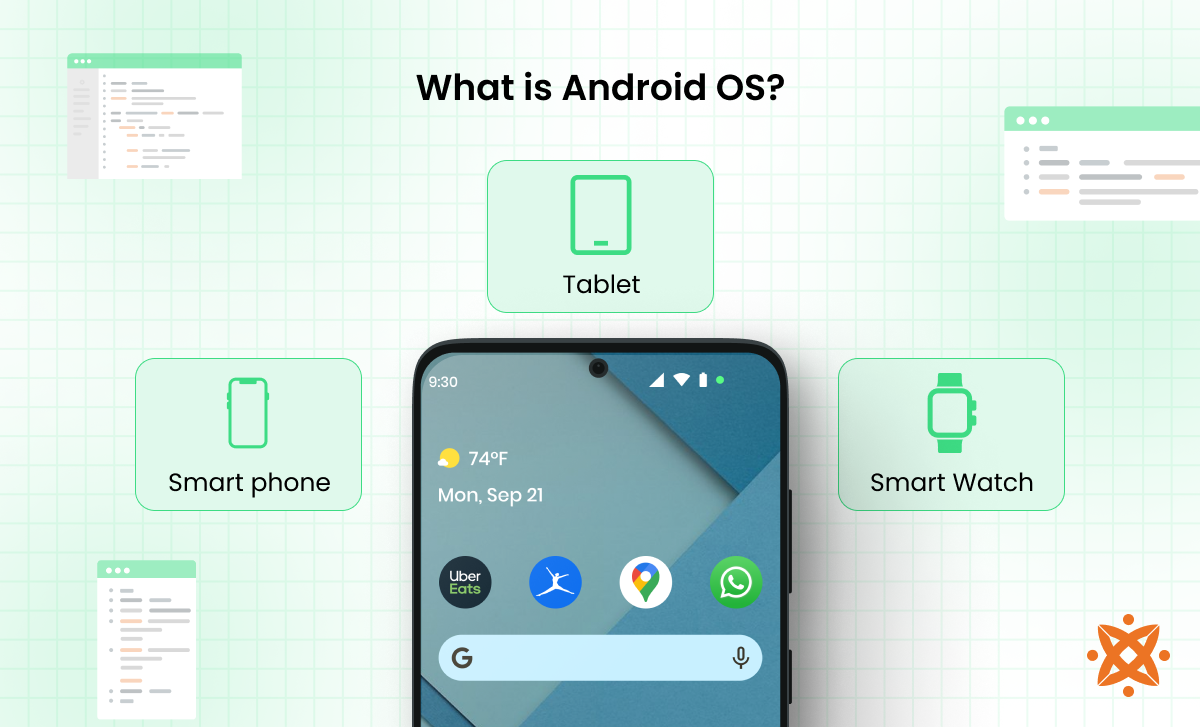
Developed with a focus on customisation and user experience, it is based on the Linux kernel and supports a wide range of applications. Known for its open-source platform, Android allows developers to create diverse apps and functionalities, making it one of the most adaptable operating systems globally.
The Android Operating System drives a vast ecosystem of Android devices, enabling users to perform various tasks such as communication, navigation, entertainment, and productivity.
It supports millions of apps available on the Google Play Store and offers features such as multitasking and an intuitive user interface. The OS also provides robust system features such as voice commands and advanced security options.
Google acquired the Android Operating System in 2005. Under its stewardship, Android has evolved into a market-dominating operating system, powering billions of devices worldwide. Google continuously updates Android to introduce innovative features, improve user experiences, and improve security, solidifying its position as a leader in the tech industry.
Android, as an entity, does not have a direct net worth. Its integration with Google's ecosystem significantly contributes to the company's overall valuation. As of December 2024, Alphabet Inc. (Google's parent company) has a market capitalisation of approximately $2.409 trillion, according to a report by Companies Market Caps.
Android drives substantial revenue for Google through the Google Play Store, app advertisements, and services like Google Cloud, making it a cornerstone of Google's financial success. As of November 2024, Android has a 71.42% market share worldwide. In the US, over 3 billion Android devices are currently active, according to a report by Backlinko.com.
According to a report by Statista, Android holds a substantial market share in the UK, powering over 45.5% of all smartphones as of June 2024. The operating system is particularly popular among younger demographics, who value its customizability and affordability. With access to millions of apps on the Google Play Store, Android continues to dominate as a leading mobile operating system in the UK.
What are the Different Versions of Android OS?
The different versions of Android OS are Android 12, Android 13, and Android 14, showcasing the platform's ongoing innovation and adaptability. Each version builds upon its predecessor, introducing improved features and capabilities to meet evolving user needs. The latest, Android 14, accentuates performance and accessibility with advanced AI-driven features and optimisations for foldable devices and tablets.
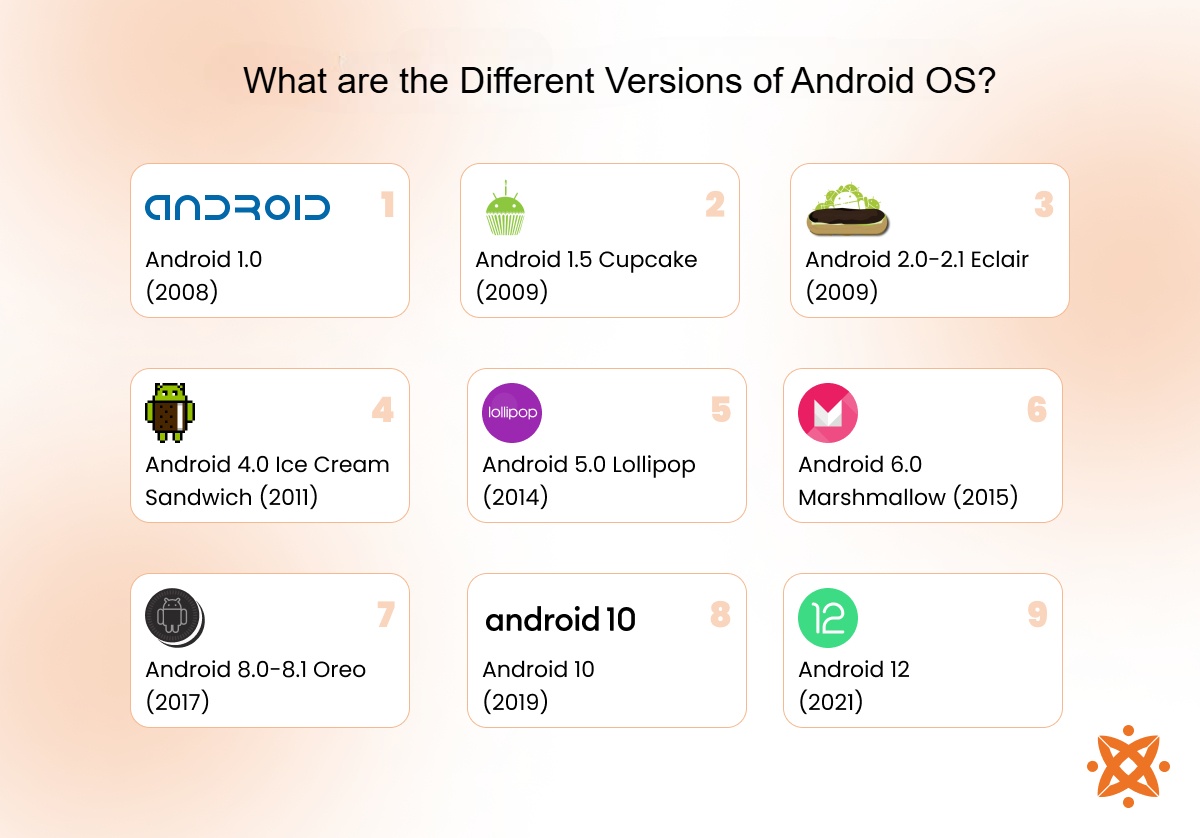
The different versions of Android OS are as follows:
- Android 1.0 (2008): The first release marked the beginning of the Android journey, introducing basic functionalities like web browsing, messaging, and the Google Play Store (then called Android Market). It laid the foundation for the OS's future evolution.
- Android 1.5 Cupcake (2009): This update introduced the on-screen keyboard and third-party app widgets, improving usability and personal customisation. It set the stage for Android's focus on user-friendly interfaces.
- Android 2.0-2.1 Eclair (2009): Eclair introduced live wallpapers and Google Maps navigation, making Android more interactive and practical for daily tasks. These were significant steps toward the best Android OS at the time.
- Android 4.0 Ice Cream Sandwich (2011): This version unified the tablet and smartphone experience, offering a cleaner and more intuitive design. Face Unlock debuted, signalling Android's growing focus on security.
- Android 5.0 Lollipop (2014): Lollipop brought Material Design, a visually cohesive design language that became a hallmark of Android. It also improved battery life with Project Volta.
- Android 6.0 Marshmallow (2015): Marshmallow introduced app permissions and fingerprint recognition, enhancing privacy and usability. Google Now on Tap provided contextual assistance.
- Android 8.0-8.1 Oreo (2017): Oreo refined performance with features like background limits and Picture-in-Picture mode, allowing multitasking. It was regarded as one of the best Android OS versions for productivity.
- Android 10 (2019): Dropping dessert names, Android 10 introduced system-wide dark mode, improved privacy controls, and better gesture navigation, aligning with modern trends.
- Android 12 (2021): This version highlighted personalisation and security, featuring a dynamic colour theme and a privacy dashboard. It showcased Android's continuous evolution toward user-centric design.
What Hardware Platform Does Android Use?
Android uses various hardware platforms, including ARM, x86, and x86-64 architectures, to power its wide range of Android devices. These hardware platforms provide the necessary computational capability and compatibility to support Android's mobile operating system, ensuring improved performance and adaptability across different devices.
ARM (Advanced RISC Machine) is the most commonly used platform for Android devices. Known for its energy efficiency and performance balance, ARM is widely adopted in smartphones, tablets, and wearables. Its design prioritises power-saving, making it ideal for devices requiring long battery life. ARM's broad adoption in Android stems from its compatibility with the system's kernel support and system features.
Android devices, such as laptops and certain tablets, predominantly use the x86 architecture. Developed by Intel, this platform offers high performance and is optimised for multitasking. Android's open-source platform ensures that x86 devices run the OS efficiently, meeting the needs of users seeking powerful computing abilities on Android-based hardware.
An extension of x86, x86-64 supports 64-bit processing, enabling faster performance and the ability to handle larger memory capacities. This platform is particularly suited for high-performance Android devices and applications requiring substantial computational resources. It improves device compatibility checks, ensuring integration of Android's features on advanced hardware.
Is Android OS Open Source?
Yes, Android OS is open source. The operating system is based on the Linux kernel and released under the Android Open Source Project (AOSP), which allows developers to access, modify, and distribute their source code freely. This open-source platform enables widespread customisation and adaptability, making it a favourite among device manufacturers and developers. Some components, like Google Play Services and certain system features, are proprietary and not open source.
What is the Difference Between the Android Desktop OS and the Android Mobile OS?
The main difference between Android desktop OS and Android mobile OS is their primary design purpose. Android desktop OS is optimised for larger screens and multitasking, while Android mobile OS is designed for smaller, touch-based devices like smartphones and tablets.
Android desktop OS, such as Chrome OS with Android app support, caters to desktop and laptop users and includes features like windowed apps, mouse and keyboard compatibility, and advanced system features for productivity. On the other hand, Android mobile OS prioritises a user interface suited for touch gestures, one-handed use, and mobile connectivity.
The two also differ in device compatibility checks—desktop OS variants support x86-64 hardware platforms, whereas the mobile OS predominantly runs on ARM. Both platforms leverage the open-source platform nature of Android to deliver versatile and adaptable experiences.
What is the Difference Between Android OS and the Android System?
The main difference between Android OS and Android System is that Android OS refers to the entire mobile operating system responsible for running Android devices, while Android System refers to the core components and services within the OS that manage fundamental functions like notifications, system updates, and device performance.
Other differences include their scope and functionality. Android OS encompasses the complete framework, including user-facing features, app ecosystems like the Google Play Store, and hardware platform support such as ARM and x86 architectures. In contrast, the Android System operates behind the scenes, ensuring the proper functioning of system features like battery optimisation, connectivity, and kernel support.
Android OS defines the user experience and the interface, while the Android System ensures that the underlying processes work effortlessly to provide a stable and efficient platform.
How Does Android OS Work?
Android OS works by serving as a bridge between the device hardware and the applications, ensuring streamlined communication and functionality. At its core, Android is built on the Linux kernel, which provides fundamental kernel support for hardware components like processors, memory, and peripheral devices. The OS manages system resources, ensuring efficient multitasking, security, and performance across various hardware platforms, including ARM, x86, and x86-64 architectures.
The Android Operating System functions through layers. The base layer is the Linux kernel, which handles hardware interactions. Above it sits the Android Runtime (ART), which enables apps to run efficiently. The application framework layer offers APIs and system services like notifications, UI rendering, and location services, making it easier for developers to build apps. Finally, the user interface layer provides a customisable experience, allowing users to interact with apps and system features intuitively.
Android's modularity, facilitated by its open-source platform, enables device manufacturers to tailor the OS to their products while maintaining device compatibility checks. This adaptability, paired with features like the Google Play Store, ensures that Android runs efficiently on a wide range of devices, from smartphones to tablets and smart TVs.
What is the History of Android OS?
The history of Android OS began in 2003 when it was founded by Andy Rubin, Rich Miner, Nick Sears, and Chris White as a startup focused on creating an operating system for digital cameras. Later, the vision shifted to developing a mobile operating system, and in 2005, Google acquired Android Inc., setting the stage for its global expansion.
The first Android version, Android 1.0, was launched in 2008 alongside the HTC Dream (T-Mobile G1). It introduced basic smartphone functionalities like a web browser, email, and the Google Play Store (then Android Market).
Over the years, Android's evolution has been marked by significant milestones, such as the introduction of touchscreen interfaces, app widgets, and advanced system features like voice commands and biometric security.
From early versions like Cupcake and Eclair to modern iterations like Android 12 and 13, the platform has consistently innovated to improve user experience and device compatibility checks. It has also diversified to control devices beyond smartphones, including tablets, smart TVs, and wearables.
Android's open-source platform and adaptability have made it a dominant force in the global tech ecosystem, with billions of active users worldwide.
What are the Core Features of an Android OS?
The core features of an Android OS include its open-source nature, customisable user interface, and extensive app ecosystem. These features make Android one of the most versatile and widely used mobile operating systems globally. The OS's adaptability allows manufacturers to tailor it to different hardware platforms while users benefit from a feature-rich experience with broad app compatibility.
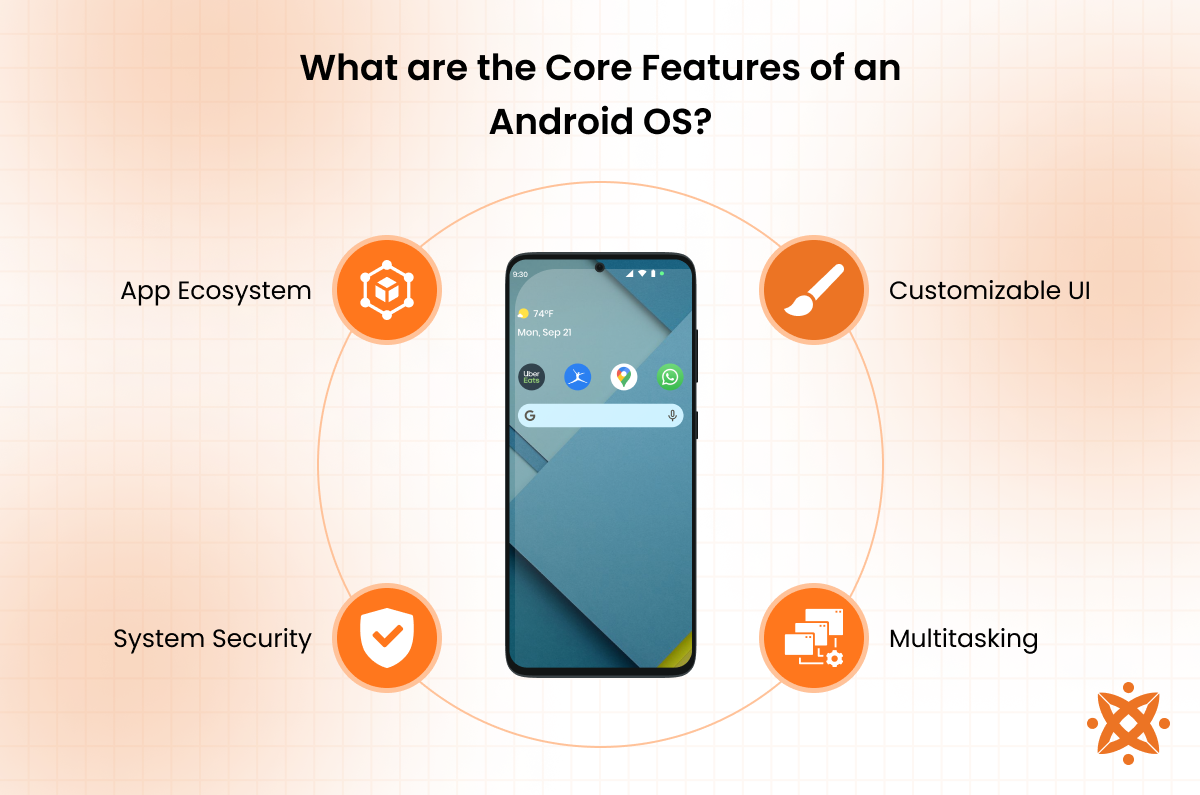
The core features of an Android OS are as follows:
- App Customization: Android allows extensive app customisation through its open-source platform, enabling developers to design and modify applications. Users benefit from a wide variety of apps available on the Google Play Store, along with the ability to personalise app settings, widgets, and themes, ensuring an individualised user experience.
- Multitasking: Android's efficient architecture supports multitasking, enabling users to run multiple apps simultaneously. Features like split-screen mode and Picture-in-Picture improve productivity, allowing users to interact with several apps without losing functionality.
- System Security: Android prioritises user safety with robust system features like biometric authentication, app permissions, and regular security updates. The OS also incorporates sandboxing to isolate apps and protect sensitive data, ensuring a secure environment for users.
What are the Advantages and Disadvantages of Android OS?
The advantages of Android OS are its customizability, wide hardware compatibility, and app diversity, whereas fragmentation, security risks, and resource dependency stand out as significant disadvantages. These characteristics highlight the OS's flexibility and challenges, making it both versatile and complex.
The advantages of Android OS are as follows:
- Customisability: Android's open-source platform allows developers and users to modify the OS extensively. From custom ROMs to personalised widgets and themes, Android offers unparalleled flexibility in tailoring the user experience.
- Wide Hardware Compatibility: Android's adaptable architecture supports a broad range of hardware platforms, including ARM and x86, making it compatible with a variety of devices like smartphones, tablets, smart TVs, and wearables.
- App Diversity: The Google Play Store hosts millions of applications across various categories, ensuring users find tools, games, and utilities to meet virtually any need. This vast ecosystem is a significant draw for consumers and developers alike.
- Affordability: Android powers devices across all price ranges, making it accessible to a diverse global audience. Its availability on budget-friendly smartphones promotes digital inclusion.
- Multitasking: Android's system features, like split-screen and Picture-in-Picture, enable effective multitasking, allowing users to interact with multiple apps simultaneously.
- Frequent Updates: The Android team and device manufacturers regularly roll out updates to improve performance, introduce new features, and address security vulnerabilities, ensuring the OS remains relevant and secure.
- Integration with Google Services: Smart integration with Google's ecosystem, including Gmail, Google Maps, and Google Drive, enriches users' productivity and convenience.
The disadvantages of Android OS are as follows:
- Fragmentation: The large number of Android device manufacturers leads to fragmented software versions, with many devices running outdated OS versions. This fragmentation limits access to new features and security updates.
- Security Risks: As an open-source platform, Android is more susceptible to malware and cyberattacks. Users must be cautious when downloading apps from unofficial sources.
- Resource Intensive: High-performance Android devices require powerful hardware, which drains battery life and increases costs for flagship models.
- Bloatware: Many manufacturers preinstall unnecessary apps, or “bloatware,” which consume storage and slow down device performance, detracting from the user experience.
- Inconsistent User Experience: Due to manufacturer customisations and varying device compatibility checks, Android devices differ significantly in performance and user interface, leading to a conflicting experience.
- Delayed Updates: Unlike iOS, Android updates depend on manufacturers and carriers, resulting in delays in receiving the latest OS versions for many devices.
- App Quality Variability: While the Play Store offers a large selection, the quality of apps varies significantly. Some are poorly developed or potentially harmful.
What are the Requirements for Developing an Android OS Mobile App?
The requirements for developing an Android mobile app include a development environment, programming skills, and app design frameworks. These components are important for building functional and engaging applications tailored to Android devices.
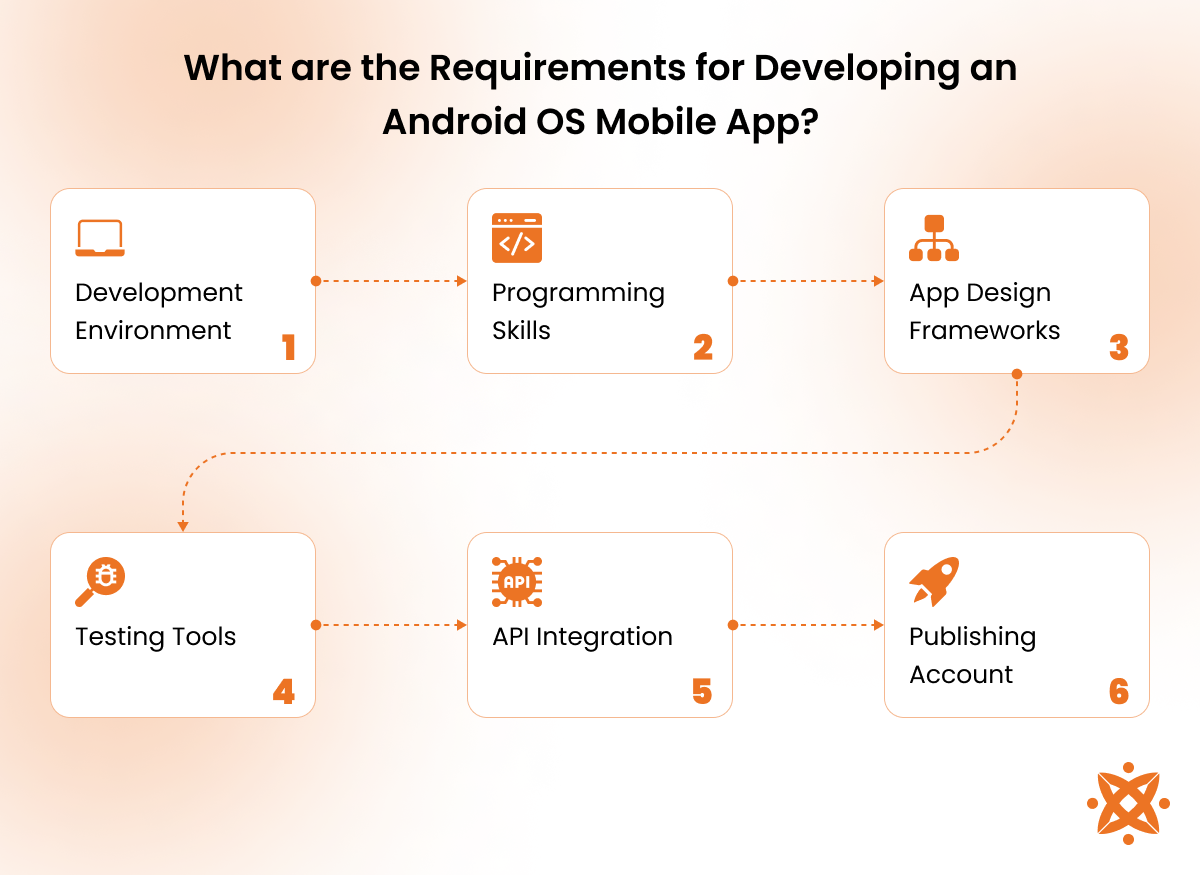
The requirements for developing an Android OS mobile app are as follows:
- Development Environment
- Programming Skills
- App Design Frameworks
- Testing Tools
- Device Compatibility Knowledge
- API Integration
- Publishing Account
1. Development Environment
A robust development environment is the foundation of Android app development. Android Studio is the official IDE, offering features like intelligent code editing, debugging tools, and performance analysis. It includes a Gradle-based build system for efficient app compilation and an emulator that mimics various Android devices for testing.
Additional tools, such as the Android SDK (Software Development Kit), provide libraries, APIs, and command-line utilities to streamline the development process. Mastering these tools ensures an efficient workflow and app development.
2. Programming Skills
Android development requires proficiency in Java or Kotlin. Kotlin, the preferred language for modern Android apps, offers concise syntax and robust safety features, such as null safety. Developers must also understand Android-specific libraries, such as Jetpack, for lifecycle management and UI components. Knowledge of object-oriented programming (OOP), multithreading, and memory management is important for building scalable and efficient apps that perform well across various devices.
3. App Design Frameworks
App design frameworks, such as XML for layout design and Material Design guidelines, are required to create intuitive and visually appealing user interfaces. Material Design offers a comprehensive set of design principles and components, including typography, motion, and layout grids, ensuring consistency across Android devices.
XML files define the app's UI elements, while tools like ConstraintLayout and Compose simplify layout creation. These frameworks ensure that apps are user-friendly and comfortably adapt to different screen sizes and resolutions.
4. Testing Tools
Testing is a necessary phase of Android app development, ensuring functionality, performance, and stability. Tools like Espresso enable automated UI testing, while Firebase Test Lab allows developers to test apps on various physical and virtual Android devices. Unit testing frameworks like JUnit ensure individual components work as intended. Debugging tools in Android Studio, such as Logcat and Profiler, help identify performance bottlenecks and memory leaks, ensuring the app meets quality standards.
5. Device Compatibility Knowledge
Android apps need to be compatible with a wide range of devices and hardware architectures, including ARM, x86, and x86-64. Developers must also optimise apps for different screen sizes, resolutions, and aspect ratios to provide a consistent user experience. Knowledge of backward compatibility managed through Android's Support Library and Jetpack ensures apps run effectively on older OS versions without compromising functionality.
6. API Integration
APIs enable apps to communicate with external services and expand functionality. Familiarity with RESTful APIs is important for tasks like retrieving data from a server or integrating third-party services such as social media, maps, or payment gateways. Android-specific APIs, like Google Maps API for location-based services or Firebase for cloud storage and real-time database access, allow developers to improve app features and provide dynamic user experiences.
7. Publishing Account
A Google Play Developer Account is required to distribute apps on the Google Play Store. The one-time registration fee allows developers to publish and manage their apps, access analytics tools, and respond to user reviews. Publishing involves creating a detailed app listing with descriptions, screenshots, and promotional content. Developers must also adhere to Google's Play Store policies and perform regular updates to maintain app visibility and user trust.
What Programming Languages are Used to Develop Android OS Apps?
Programming languages that are used to develop Android OS apps include Java, Kotlin, C++, and Dart. These languages are integral to Android development, with each serving different purposes and offering distinct advantages.
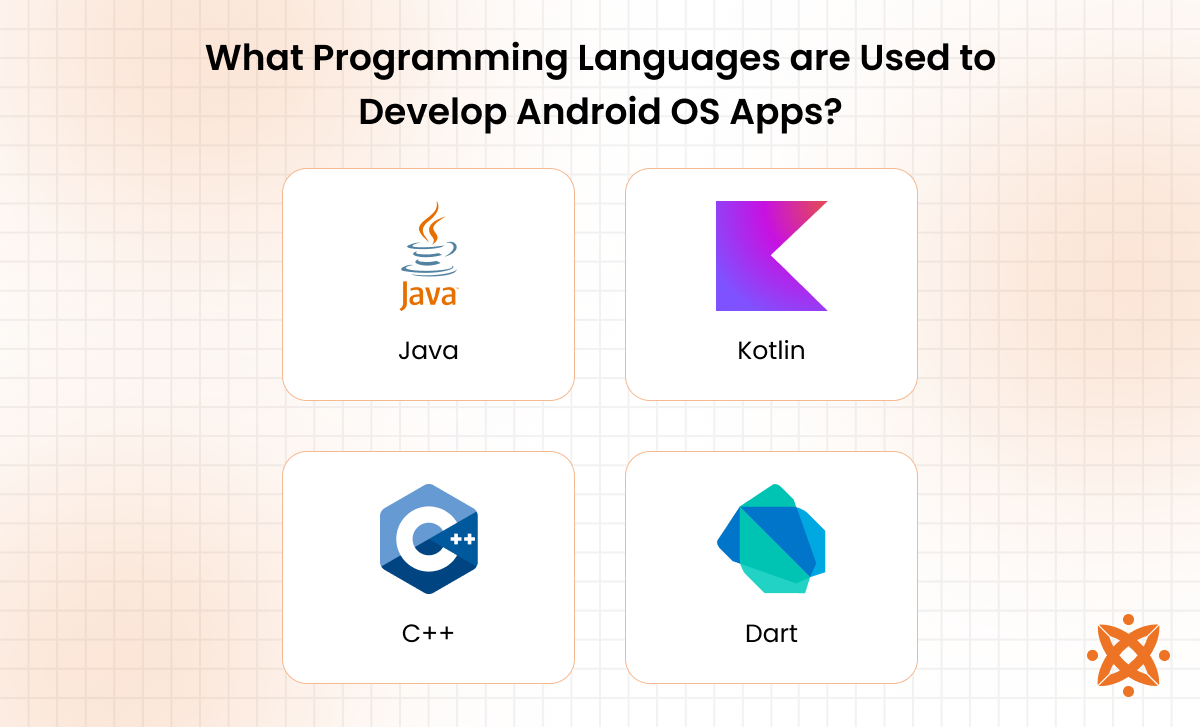
Programming languages that are used to develop Android OS apps are as follows:
- Java: Java has been the primary language used in Android development since its inception. It is an object-oriented programming language known for its portability, ease of use, and extensive libraries. Java remains widely used for Android app development due to its robustness, compatibility with Android's architecture, and large developer community.
- Kotlin: Google officially supports Kotlin as the preferred language for Android development. It is a modern, concise language that runs on the Java Virtual Machine (JVM). Kotlin offers improved syntax, null safety, and interoperability with Java. It helps developers write cleaner, more readable code with fewer lines, improving productivity and reducing the likelihood of bugs.
- C++: C++ is used for more performance-critical parts of Android apps, particularly when dealing with complex algorithms or hardware interaction. It is commonly used in developing apps that require low-level system access or high-performance gaming apps, leveraging the Android NDK (Native Development Kit) to create native apps.
- Dart: Dart is used to develop cross-platform apps, particularly with the Flutter framework. Although not exclusive to Android, Dart allows developers to write apps that run on both Android and iOS from a single codebase. It provides fast development cycles, allowing developers to prototype and test Android apps quickly.
What are the Best Practices for Android App Development?
The best practices for Android app development are optimising app performance, following Material Design guidelines, and ensuring compatibility across devices. These practices provide an integrated, user-friendly experience while maintaining efficiency and reliability.
The best practices for Android app development are as follows:
- Optimise App Performance: Efficient performance is important for user satisfaction. Developers should minimise memory usage, optimise battery consumption, and use background threads for heavy tasks to keep the app responsive. Tools like Android Profiler help monitor performance and identify bottlenecks.
- Follow Material Design Guidelines: Adhering to Material Design ensures a consistent and intuitive user interface. These guidelines provide standards for layout, typography, colour schemes, and animations, helping developers create visually appealing and accessible apps that work efficiently on Android devices.
- Ensure Compatibility Across Devices: Android apps must function smoothly across a wide range of devices with varying screen sizes, resolutions, and hardware configurations. Using responsive design principles, testing with emulators and physical devices, and leveraging libraries like Jetpack ensure compatibility and a consistent user experience.
- Implement Secure Coding Practices: Security is paramount in app development. Developers should safeguard user data by encrypting sensitive information, using secure network protocols, and avoiding hardcoding credentials. Regular updates to address vulnerabilities also improve app security.
- Use Modular Architecture: Modular architecture, such as Model-View-ViewModel (MVVM) or Clean Architecture, makes apps easier to maintain, test, and scale. This approach separates concerns within the app, improving code readability and reducing dependency.
- Test Thoroughly: Comprehensive testing ensures the app functions as intended under various conditions. Developers should conduct unit tests, integration tests, and user interface tests using tools like Espresso and Firebase Test Lab to catch bugs early and improve app stability.
- Keep the App Lightweight: Apps with smaller APK sizes are more likely to be downloaded and installed. Developers should compress images, minimise dependencies, and avoid unused resources to keep the app lightweight without sacrificing features.
What are Android OS Alternatives?
Android OS alternatives are iOS, HarmonyOS, and Ubuntu Touch. These operating systems offer unique features and cater to various user needs, providing diverse options for mobile devices beyond Android.
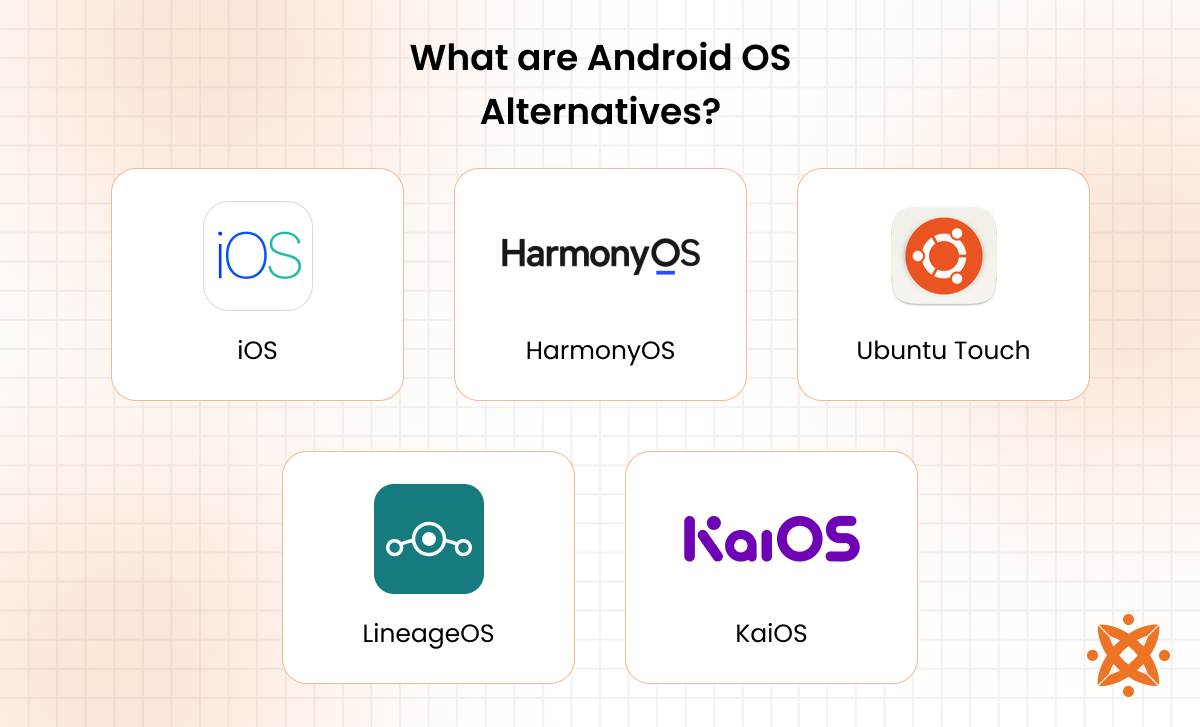
Android OS alternatives are as follows:
- iOS: Developed by Apple, iOS is a closed-source Mobile Operating System that powers iPhones and iPads. Known for its unified integration with Apple's ecosystem, iOS offers a polished User Interface, robust security features, and exclusive apps through the Apple App Store.
- HarmonyOS: Created by Huawei, HarmonyOS is a versatile Open-source Platform designed for smartphones, tablets, and IoT devices. It focuses on cross-device connectivity and offers a smooth, unified experience across multiple devices, making it a strong contender in the mobile OS market.
- Ubuntu Touch is an open-source platform tailored for mobile devices that emphasises privacy, security, and community-driven development. It offers a unique convergence feature that enables users to transform their smartphones into desktop-like experiences when connected to external displays.
- LineageOS: LineageOS is a popular open-source Android-based alternative that accentuates user customisation and privacy. It provides frequent updates and a lightweight experience, especially for older devices no longer supported by official Android updates.
- KaiOS: Designed for feature phones, KaiOS is a lightweight operating system that bridges the gap between traditional phones and smartphones. It supports basic apps, internet access, and longer battery life, catering to users who prefer simple, functional devices.
What is the Difference Between Android OS and iOS?
The main difference between Android OS and iOS is their level of openness. Android is an open-source platform that allows extensive customisation by users and manufacturers, whereas iOS is a proprietary system exclusive to Apple devices with a more controlled and uniform experience.
Android powers a wide range of devices from various manufacturers, whereas iOS is restricted to Apple products such as iPhones and iPads. Android apps are distributed primarily through the Google Play Store, while iOS apps are accessed through the Apple App Store. Both systems offer unique ecosystem experiences tailored to their user bases.
What is the Difference Between Android OS and Chrome OS?
The main difference between Android OS and Chrome OS is their target use cases. Android is a Mobile Operating System designed for smartphones and tablets, whereas Chrome OS is a lightweight, web-centric operating system primarily intended for laptops and Chromebooks.
Android OS focuses on running apps locally on devices, offering a rich ecosystem of applications for various purposes. In contrast, Chrome OS is optimised for cloud-based computing, with most applications running via the Chrome browser. While Android apps run on Chrome OS (via compatibility features), the core design philosophy of the two systems remains distinct.
What is the Difference Between Android OS and Windows OS?
The main difference between Android OS and Windows OS is their target platforms. Android is a Mobile Operating System designed for smartphones and tablets, while Windows OS is a desktop and laptop operating system geared toward productivity and enterprise environments.
Android OS relies on ARM and x86-64 architectures for mobile devices, offering touch-centric interfaces and app-based ecosystems. In contrast, Windows OS supports a broader range of hardware platforms, including PCs and servers, and provides a more traditional desktop experience with extensive software support for professional and personal use.
What is the difference between Android OS and HarmonyOS?
The main difference between Android OS and HarmonyOS is their underlying architecture and ecosystem focus. Android is built on the Linux kernel and primarily targets smartphones and tablets, while HarmonyOS is a distributed operating system designed for cross-device connectivity, including IoT devices.
Android OS powers a vast ecosystem of Android Devices, offering extensive customisation and app availability through the Google Play Store. HarmonyOS, developed by Huawei, accentuates integration across a variety of devices, such as smart TVs, wearables, and smartphones, providing a unified and connected user experience.
What is the Difference Between Android and Linux?
The main difference between Android and Linux is their purpose. Android is a Mobile Operating System built on a modified version of the Linux kernel, specifically tailored for smartphones, tablets, and other consumer devices, while Linux is a general-purpose, open-source operating system used across servers, desktops, and embedded systems.
Android adds a user-friendly interface, app ecosystem, and features designed for mobile users, making it suitable for consumer electronics. In contrast, Linux offers greater flexibility for developers, administrators, and professionals who need control over system features, with no specific focus on mobile platforms.
What are the Best Android OS Emulators?
The best Android OS emulators are BlueStacks, NoxPlayer, and Android Studio Emulator. These emulators provide powerful tools for running Android apps on PCs or testing apps during development. Each offers unique features tailored to different user needs.
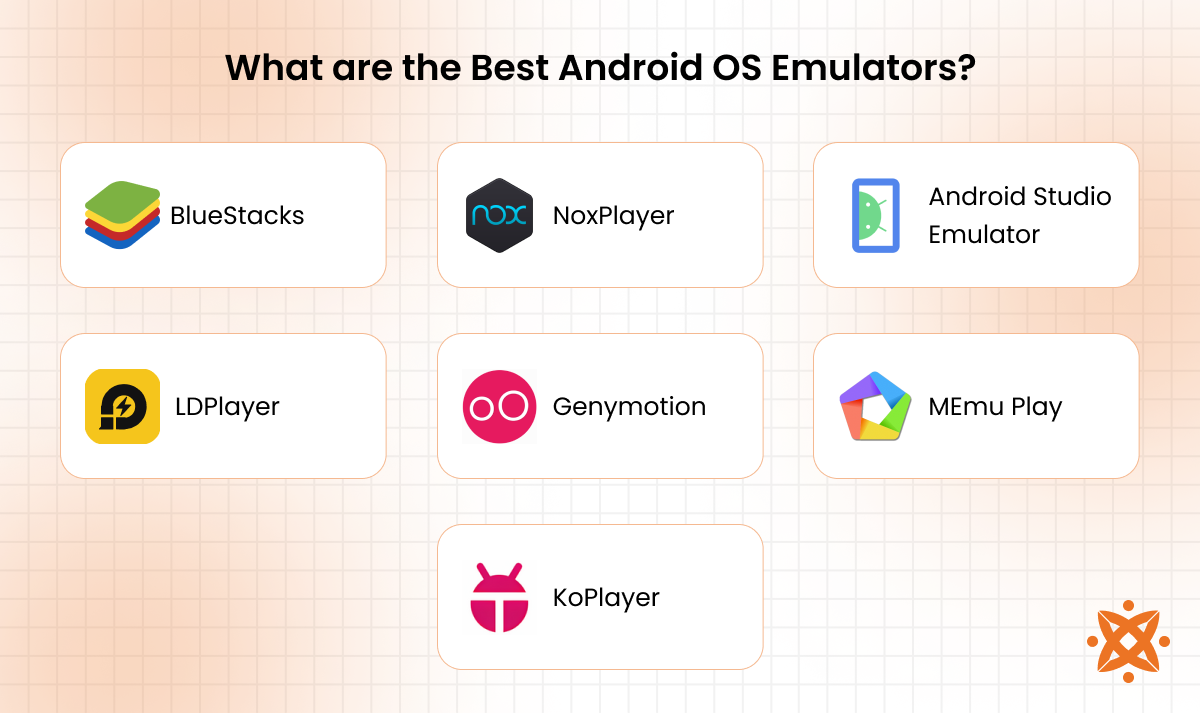
The best Android OS emulators are as follows:
- BlueStacks: BlueStacks is one of the most popular Android emulators for running Android apps and games on Windows and macOS. It offers a user-friendly interface, high performance, and support for keymapping, making it ideal for gamers and casual users alike.
- NoxPlayer: NoxPlayer is another excellent choice, particularly for gaming. It provides advanced features like script recording, controller support, and multiple-instance handling, allowing users to run multiple Android apps or games simultaneously.
- Android Studio Emulator: The Android Studio Emulator is a professional-grade tool designed for developers. Integrated into the Android Studio IDE, it allows developers to test apps thoroughly across various Android versions and device configurations, offering unparalleled accuracy and flexibility.
- LDPlayer: LDPlayer is optimised for gaming. It has minimal system requirements and features like multi-instance synchronisation and high FPS support. It is a lightweight emulator that performs well even on less powerful hardware.
- Genymotion: Genymotion is a cloud-based emulator favoured by developers for its scalability and support for testing apps on various Android versions. It offers features like GPS simulation, battery level simulation, and device rotation, making it a comprehensive tool for app development.
- MEmu Play: MEmu Play is known for its efficiency and speed, particularly for gaming. It supports multiple instances, allowing users to play various games or run different apps simultaneously on the same machine.
- KoPlayer: KoPlayer is a straightforward emulator focusing on performance and stability, making it suitable for both gaming and general app usage. Its intuitive interface appeals to beginners and casual users.
How to Choose an Android App Development Company?
To choose an Android app development company, you should evaluate their expertise, portfolio, and ability to deliver tailored solutions. Look for companies with a proven track record of developing innovative, user-friendly Android apps and a clear understanding of your business needs.
To choose an Android app development company, the following things are considered:
- Experience and Expertise: Ensure the company has extensive experience in Android app development and a skilled team proficient in the latest technologies and system features.
- Portfolio and Case Studies: Review their past projects to assess the quality and diversity of their apps. A strong portfolio reflects their ability to deliver successful apps across industries.
- Client Reviews and Testimonials: Check feedback from previous clients to gauge customer satisfaction and the company's reliability. Positive reviews indicate good client relationships and dependable service.
- Development Process and Transparency: Choose a company that follows a transparent development process, provides regular updates, and engages you in key decisions.
- Technical Support and Maintenance: Post-launch support is required. Ensure the company offers ongoing maintenance and updates to keep your app secure and functional.
- Cost-effectiveness: Compare pricing and service quality among competitors to ensure you receive value for your investment.
- Customisation Capabilities: The company should be able to tailor the app to your specific needs, offering flexibility and scalability as your business grows.
If you're in the UK, consider Intelivita, a leading Android app development company known for delivering innovative solutions tailored to diverse business needs.
Never Miss an Update From Us!
Sign up now and get notified when we publish a new article!
Dhaval Sarvaiya
Co-Founder
Hey there. I am Dhaval Sarvaiya, one of the Founders of Intelivita. Intelivita is a mobile app development company that helps companies achieve the goal of Digital Transformation. I help Enterprises and Startups overcome their Digital Transformation and mobile app development challenges with the might of on-demand solutions powered by cutting-edge technology.
